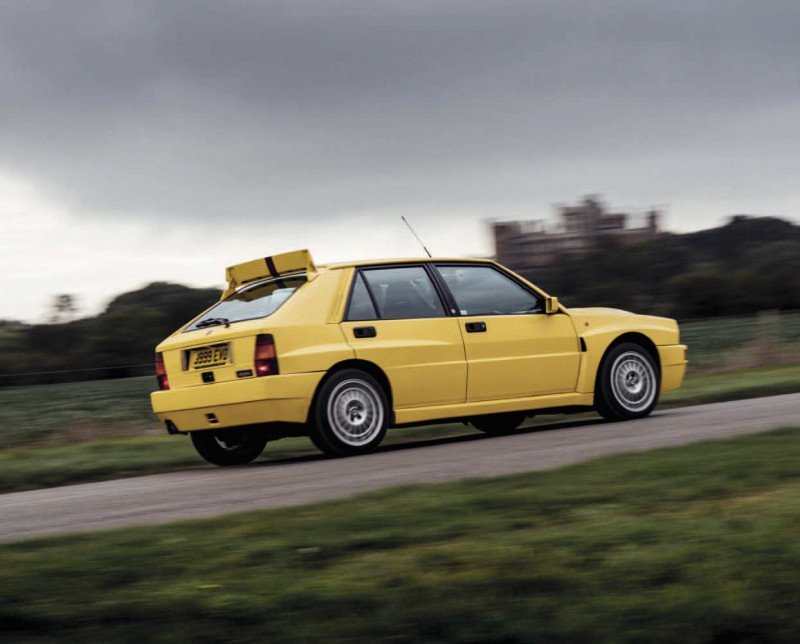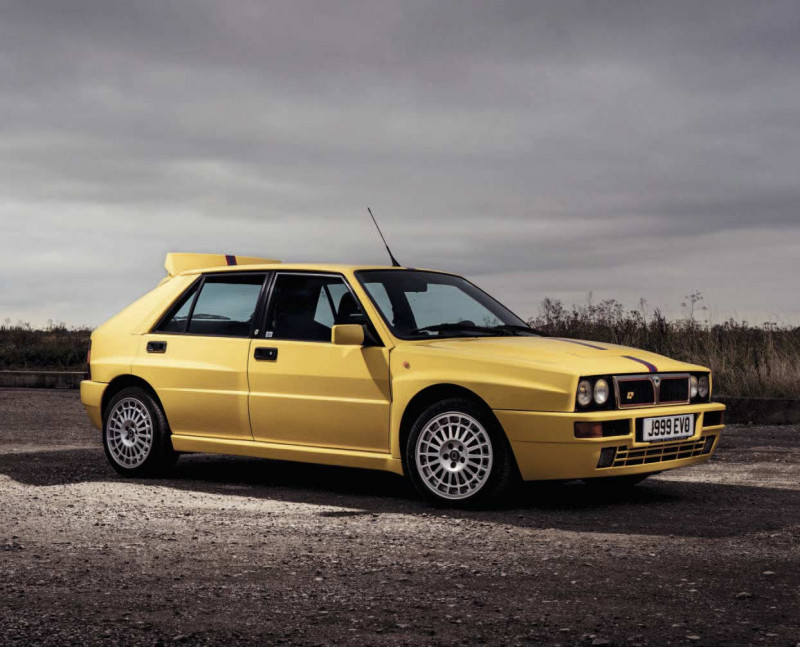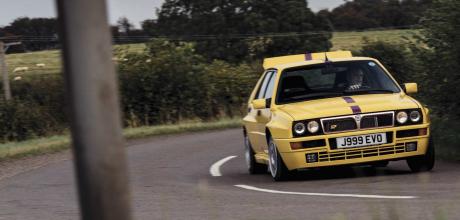1993 Lancia Delta HF Integrale Evoluzione II
Lancia and rallying were once synonymous, the Delta Integrale being among the greatest homologation specials ever to scorch a special stage. It hasn’t lost the power to thrill, either, as we discover after braving one with more than 300bhp. Words: Richard Heseltine. Pictures: Simon Thompson.
TAMING LANCIA’S ERA-DEFINING SPECIAL STAGE CONQUEROR
1993 Lancia Delta HF Integrale Evoluzione II
That’s a first. If we are not mistaken, that was a thumbs up and a flash of the lights. He seemed happy to see us, that’s for sure, but then so did the Lycra-clad bicyclist a few minutes ago; the one who nodded ascent rather vigorously before breaking into a toothy smile. It’s all so… unexpected. Spend five minutes in a vowel-laden supercar and onlookers will invariably make judgements about you; unkind ones, mostly. In marked contrast, everyone seems to love a steroidal yellow hatchback rocking a big wing and go-quicker stripes.

But then so much about the Lancia Delta Integrale makes you regress to a state of childlike wonder. The thuggish looks proclaim invincibility, but If they don’t grab your attention, its outsized stature assuredly does. The Integrale – or integrale, depending on whose estimates you credit – was a colossus in motor sport. It owned the World Rally Championship, season after season, and that’s before you factor in success at national level. Its reputation proceeds it. This cubist Lancia was also among the greatest homologation specials ever to turn a wheel in anger and, by extension, one of the most exalted road cars of its generation.
“This is a car where you accept the mad with the maddening. The Lancia is far from perfect, but it is bloody brilliant.”
The older it gets, the more exceptional the Integrale appears. Nevertheless, 28 years have elapsed since production of the last truly notable Lancia ended. The passing of time has ensured its legend has been burnished, but the problem with legends is that they tend not to bear close scrutiny in real life. The more you scrape away the purple gush, the more you realise the mythology is precisely that. As such, you approach this boxy throwback wondering if it really as good as you remember; has it been eclipsed by newer fare? It is, after all, a silverback among road-going rally cars.

In order to understand the Integrale’s place in the general scheme of things, first you need to understand why it was created. Think back to the early- to mid-1980s and rallying underwent a seismic shift. The Group B years represented the most extreme period of off-piste motor sport yet witnessed. It was a time where steroidal cars that bore only token resemblance to production models scorched special stages; an age of heroic drivers, protests and counter protests, plus more than a little tragedy. For five mostly glorious seasons, rallying was anything but dull and formulaic.
However, the World Rally Championship suffered a hammer blow in 1986 when the FISA governing body scrapped plans for its new top-flight Group S category (for pure-bred prototypes where just ten replicas needed to be made to meet homologation requirements). It also abruptly called time on Group B in the light of Henri Toivonen and Sergio Cresta’s fateful accident on the Tour de Corse. These mid-engined blunt instruments were deemed too fast and accordingly too dangerous. New regulations called for production-based Group A cars for 1987 on, Lancia being quick off the mark creating an all-new weapon using experience garnered from the monstrous Delta S4.
Abarth, which had become Fiat and Lancia’s de facto competition department, was responsible for conjuring this new weapon. Strictly speaking, though, the story stretched back to 1971 when Fiat acquired a 50% stake in the marque of the scorpion and moved its motor sport operation into the factory located at Corso March, Turin shortly thereafter. By 1977, Lancia’s competition department was also brought under one roof with Cesare Fiorio becoming the boss of bosses of all Fiat/Lancia motorsport activities. He was a man famously undaunted by high-stakes challenges.
Basis for the new Group A machine was the Delta in rather more familiar form relative to its mid-engined predecessor. When introduced in 1979, there were few pointers to the Delta becoming a performance icon. Rooted in the Fiat Strada, with an angular outline penned by Giorgetto Giugiaro, this hatch was anything but hot for all its virtues. Sure, it was recipient of a Car of the Year gong the following year, but competition involvement seemed improbable. But that was then. With 165bhp from its 2.0-litre twin-cam turbo four, and an advanced all-wheel-drive system, the new HF 4WD – aka the Abarth SE030 – took the 1987 World Championship of Makes title with consummate ease.
It also won the first two rounds of the following year’s series before the Integrale picked up the baton. Launched at the 1988 Frankfurt motor show in road car form, this newest strain packed a larger Garret T3 turbocharger and an extra 20 horses relative to the outgoing model. That, and 224Ib ft of torque. Blistered arches embraced fatter tyres and grey 15-inch alloys, the 56/44 front-to-rear torque split imbuing it with preternatural levels of grip. Capable of 0-60mph in 6.6 seconds on to an aerodynamically blunted 133mph top end in roadgoing spec, this was a peerless point-to-point car.
This new strain of Delta dominated the 1988 season, bagging manufacturer honours well before the end of the campaign. And so it continued. There was no time for laurel resting, though. For the following year, Lancia introduced a new 16-valve variation to be run alongside the existing eight-valve car. Identifiable by its prominent bonnet bulge, other obvious deviations included wider wheels and tyres. With the torque split changed to 47/54 front-to-rear for better handling characteristics on asphalt, it made a successful debut in the Sanremo Rally, production cars now punching out 200bhp at 5500rpm (the 0-60mph sprint taking 5.7 seconds).
More was to come. The 210bhp Evolution model arrived in October 1991. Even wider tracks front and rear meant the already conspicuous wheelarch extensions became larger still (now a single pressing as opposed to fabricated). The front MacPherson strut top mounts were raised for better wheel articulation, new grilles were sited in the front bumper to dissipate under bonnet heat build-up, and an adjustable roof spoiler was added above the tailgate to add downforce. By the following January, Lancia had introduced the first of a bewildering raft of limited editions to the roster, the Martini-liveried ‘5 World Champion’ celebrating the Integrale’s fifth consecutive WRC triumph. By the end of the year, another title had been bagged: enter Integrale 6, complete with turquoise stitched Alcantara trim.
With works involvement in rallying ending in 1992, the Integrale was on borrowed time. The ultimate iteration arrived a year later with a revised version of the enduring ‘Lampredi’ 2.0-litre unit (power was hiked to 215bhp) and mostly cosmetic and detail improvements along with more small-run rarities (including the imaginatively named Final Edition). In November 1994, the Integrale entered into the past tense by which time 44,296 had been made. That wasn’t a bad haul for a homologation special; one which, when first released in eight-valve form, saw just 50 earmarked for the UK market. Even then, the concessionaire wasn’t convinced there was that big a market for the model.
While special stage-vanquishing saloons such as the Subaru Impreza and Mitsubishi Evo eclipsed the Lancia in the public’s affection during the 1990s, the Integrale still pushes all the right buttons among rally fans of a certain generation. Those who weren’t even born while it ruled the WRC know what an Integrale is, though, even if it’s just from console games. This 1994 example, in essence an Evo 2 in Integrale-speak despite not being labelled as such, conjures images of heroes such as Didier Auriol, Juha Kankkunen and Miki Biasion flying the friendly skies, sometimes at treetop level, aboard flame-splitting works cars. All that is lacking is the Martini warpaint. It is hard not to be overcome with a sense of romantic fascination.
‘Our’ car is one of 220 limited-run Giallo Ginestre editions. It was brought into the UK from Germany via Walkers Garage in 1997 (the Yorkshire firm being something a legend in Integrale circles as variously importers, rally entrants, performance-enhancers, and so on). The wheel in each corner stance is perfect (there’s no wasteful overhangs to clout against something on special stages), the prominent rear wing here being very much in the upright position. The Integrale looks as hard as coffin nails, as much as any car can in such an eye-watering hue. It may not be a work of great beauty, but it is brutishly compelling in a styled-by-engineers, Frankensteinian mash-up kind of way.
The same is true on the inside, even if the dashboard architecture is clearly a throwback to the 1970s, the same being true of the cheap-as-chips switchgear (one wag way back when likened them to those found in a Yugo). If nothing else, they serve as a reminder of the Integrale’s roots; that it was adapted from a 1.3-litre commuter shuttle. However, the Alcantara-trimmed Recaro buckets offer all the correct competition reference points (and are well bolstered with it), as do the black gauges with their yellow delineations.
The base car origins are also all too obvious in the driving position which is rather upright; the same is true of the windscreen. Get past all that, and head out on to a deserted back road, and the car’s true character emerges. Driving an Integrale is an education, and here that sense is heightened given that its instantly likeable owner Mark Holland has given his car a few upgrades: a bigger turbo, a few cylinder head mods, a Presto back box, a remapped ECU; that sort of thing. As such, it’s producing a gen’wine 327bhp, 112 more than the standard car. However, unlike some modded Integrales we have experienced (endured), here the changes accentuate the production car’s attributes rather than detracting from them. Not that there aren’t a few quirks to overcome first. Even in a standard Integrale, the abrupt clutch takes some mastering.
Here, the paddle clutch set-up isn’t exactly conducive to in-town trundling. It’s either in or out. However, it’s a different story at speed. Twin balancer shafts add refinement to the inline four-banger, but the Lampredi unit doesn’t sound quite as choral here as in other applications. Which isn’t to say it doesn’t play a nice tune, more that it’s a metallic, zinging rasp overlaid with a wastegate exhalations. Throttle response is also softer than you might expect; less snappy. It isn’t the all-or-nothing rally car archetype. The Integrale is, however, (insert rude word here) quick.
Traction is, of course, benchmark stuff, at least for its age. The Integrale doesn’t feel like a front-wheel-drive car with a modicum of rear-wheel assist. Instead it becomes increasingly neutral the harder you press. Agility is astounding for its vintage. It simply finds footing where other cars discover only wheelspin. Acceleration is predictably of the eye-widening variety. There are a few ergonomic quirks here and, as such, the steering wheel rather gets in the way of the important bits of the speedo and rev counter. As for the boost gauge, prior experience suggest that you don’t spend much time looking at it. You simply change up by ear as much as feel through your contact points.
That said, the turbo begins to spool up at 3000rpm, complete with the obligatory whistling chirrup, the surge from 50mph to 80mph being visceral thanks to the colossal amount of torque. You certainly know you’re moving at quite a lick: the Integrale’s mid-range pull is stupid-fast. It is clearly happiest at high revs, too. The Lancia is a lot smoother there, while the gearchange initially feels a little fluid against the stops but with plenty of gate-spring assist. There’s a sense of invincibility here, the Integrale defying the laws of physics without any understeer, oversteer, on-its-roof nastiness. It just grips and grips and then grips some more.
This situation is abetted by the steering which, while not particularly sensitive at low speed, becomes that bit more lucid when pressing on. Nor is there any of the ‘tug’ you get from some four-wheel drive cars of this ilk. The car’s ride quality is better than you might expect. There’s little thump, thump over calloused asphalt. When you do feel a bump, you know it, mind. That said, the seating position is decent enough thanks to the adjustable-height wheel, so there’s no need to adopt the expected simian driving stance.
The beauty of the Integrale is that it’s such a fine all-rounder. There’s enough straight-line performance to bait most supercars and sufficient dexterity to humble them when roads get gnarly. It’s practical, too, with seating for the family and a proper rear hatch, even if the 4WD gubbins do encroach a little on boot space. Whether young ’uns would appreciate acting as ballast is a different matter, though. Oh, and as Integrale owners are wont to point out, it’s best not to have the windows half open when enjoying yourself in the twisty stuff (the body flexes a wee bit). Some might find driving a left-hooker a chore but, to be honest, it really isn’t. You soon acclimatise.
This is a car where you accept the mad with the maddening. The Lancia is far from perfect, but it is bloody brilliant. It lives up to the billing. Its forerunners, the Stratos, 037 and Delta S4, were beyond the viewer’s reach and understanding, but that was never the case with the Integrale. When the model first arrived in the UK in its original incarnation, it wasn’t exactly cheap, but it was 25% less expensive than a comparable Toyota Celica GT-Four. As such, it was tantalisingly within reach in a way that no Group B car ever was.
In many ways, the Integrale was a means to an end. It wouldn’t have existed had Group B and its replacement carried on apace. But that didn’t happen. If nothing else, the Integrale proves that every once in a while, even the expedient can become eternal. Buckle up. Relax. Enjoy the flight.
Thanks to: Mark Holland for the generous loan of his treasured Integrale.
“It may not be a work of great beauty, but it is brutishly compelling in a styled-by-engineers, Frankensteinian mash-up kind of way.”
“In November 1994, the Integrale entered into the past tense by which time 44,296 had been made. That wasn’t a bad haul for a homologation special”


